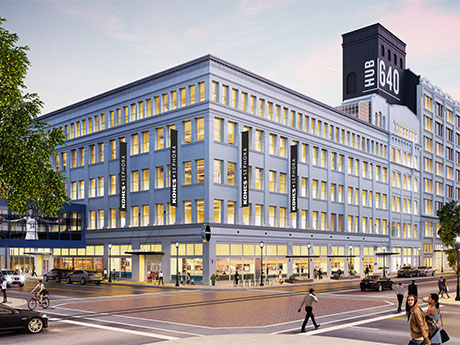By Tony Colvin and Michael Fitzgerald, Mid-America Real Estate
In the absence of significant new construction, the evolution of the retail real estate market in Milwaukee is largely being driven by the conversion and demolition of existing spaces. Some prominent places are being reimagined in creative ways that often include multifamily and other uses in addition to retail.
HUB640 in downtown Milwaukee is a perfect example. A historic building formerly occupied by a Boston Store, the property is being transformed by North Wells Capital and Urban Innovations Management. The new mixed-use project will feature Kohl’s as the retail anchor tenant, loft apartments and office space occupied by Fiserv’s corporate headquarters.

Other corporate office users, including Milwaukee Tool and Northwestern Mutual, also are betting on the central business district (CBD), with Milwaukee Tool relocating upwards of 1,200 employees, and Northwestern Mutual redeveloping and enlarging its headquarters.
At the same time, new multifamily high-rises are remaking the architecture of Milwaukee including the river and lakefronts. The 25-story Ascent opened last year, and 333 North Water (31 stories) and Couture (44 stories) are on the horizon.
Additionally, Iron District MKE is an 11-acre mixed-use sports and entertainment development slated to be phased in over the next couple of years that will include a 140-room hotel, 99-unit apartment complex, 8,000-seat soccer stadium and 3,500-seat private music venue. Each of these new developments will offer a retail component, further evidence of the strength of downtown.

The multifamily market matters to the retail sector because where there are people converging to live, work and play, opportunities are being created for retailers and alternative-use tenants to meet or create demand. (Incidentally, Milwaukee’s apartment vacancy rate at year-end 2022 was 4.3 percent, the lowest in the Midwest and one of the lowest in the U.S., according to CoStar.)
Suburban shake-out
For all the pockets of activity in the CBD, most of the retail real estate market action is occurring elsewhere on the map. The DNA in Southeast Wisconsin continues to evolve, with traditional malls being reinvented and trade areas shifting somewhat.
Where there were once five enclosed malls in the Milwaukee metro area, there will probably one day be only one, Mayfair, with two others very much reimagined: the Corners at Brookfield and Bayshore.
Together, these three properties anchor the three regional and distinct shopping districts in Milwaukee: East, Central and West. The notable fourth regional trade area, Southridge, continues to evolve with both pad development and multifamily in the planning stages. Other more recently constructed open-air centers continue to perform well in these trade areas, including 84South and White Stone Station.
Outside the Milwaukee area some of the same trends are evident. In the affluent Middleton submarket of Madison, for example, Greenway Station is thriving. The open-air center is in close proximity to dense multifamily, hotels and Class A office.
Given the lack of new product with desirably sized spaces and cotenancies, landlords are naturally seeing (and encouraging) a flight to quality among tenants at centers in the best-performing locations, pushing demand and rents higher along the way. Vacancies in these spaces where no new construction is required are filling quickly and highly competitive.
Tenants duel for locations
Categories that continue to perform well are quick-service and fast-casual restaurants, including outlets with drive-thru pick-up windows.
That’s an aftereffect of the pandemic, and the evidence is everywhere. Chick-fil-A, for example, opened its first drive-thru, pick-up-only location in the Milwaukee area last year. Multiple coffee purveyors are opening drive-thru-only concepts, including 7-Brew, Scooter’s and Starbucks.
Other chicken restaurants are hot, too, no pun intended, as are car washes, the latter representing a low-cost luxury service affordable to a wide swath of consumers.
Additionally, financial institutions have come back into the fold and are competing for pad sites, which continues to increase values and demand within the top-tier trade areas.
With prime space tight, category leaders like Chipotle Mexican Grill, Raising Cane’s, Panera Bread and Starbucks are often willing to step up and pay for the best hard-corners or other locations, which has driven some new development including pad sites.
As large, outdated department store boxes are repurposed, we’re also seeing more discount uses like Hobby Lobby, Big Lots, Harbor Freight Tools and extensions of national brands such as Sierra Trading Post by T.J. Maxx and dd’s Discounts from Ross Stores.
To the extent deals are being driven by new construction or reconstruction, they are taking longer to consummate as landlords and tenants seek to line up contractors, equity and financing, and secure local government approvals where needed. Oftentimes, larger redevelopments and repurposes require municipal assistance or are stalling until construction pricing starts to normalize to afford the developer a minimum base return to execute these types of deals.
Record year for sales
Last year was a record year for retail property sales, with deal volume hitting a high-water mark for Milwaukee, according to CoStar. Volume tailed off considerably in the second half as interest rates increased, and buyers and sellers had a harder time agreeing on price. As the market cooled, cap rates have increased.
Still, some assets continue to command a premium, namely well-performing grocery anchored centers with ancillary service retail. The product remains Internet-proof and highly resilient.
Likewise, net-leased assets remain some of the most desirable investment properties in the market, including pad sites in locations that cannot be replicated.
Tony Colvin is principal and senior vice president of tenant representation, while Michael Fitzgerald is principal and director of asset advisory services with Mid-America Real Estate. This article originally appeared in the May 2023 issue of Heartland Real Estate Business magazine.


